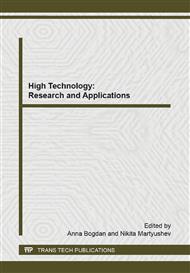[1]
Yu.R. Kolobov, et al., The role of diffusion-controlled processes in structure and properties formation of metallic nanomaterials, Composites and nanostructures. 2 (2009) 5-24.
Google Scholar
[2]
V.D. Divya, U. Ramamurty, A. Paul Topological close packed μ phase formation and the determination of diffusion parameters in the Co-Mo system, Intermetallics. 18 (2010) 259-266.
DOI: 10.1016/j.intermet.2009.07.019
Google Scholar
[3]
B. Bokstein, S. Bokstein, A. Zhuchovitsky Thermodynamics and kinetics of diffusion in solid bodies, Metallurgy, Moscow, (1974).
Google Scholar
[4]
I. Kaur, Y. Mishin, W. Gust Fundamentals of Grain Interface Boundary Diffusion, Wiley & Sons LTD, Chichester, New York (1995).
Google Scholar
[5]
C. Herzig, S.V. Divinski, Grain Boundary Diffusion in Metals: Recent Developments, Materials Transactions. 44, 1 (2003) 14-27.
DOI: 10.2320/matertrans.44.14
Google Scholar
[6]
D. Reuter, G. Gerth, J. Kirschner Modifying diffusion anisotropies: Cap layer induced changes in spreading anisotropies, J. App. Phys. 82, 11 (1997) 5374-5377.
DOI: 10.1063/1.366304
Google Scholar
[7]
G.P. Grabovetskaya, I.P. Mishin, I.V. Ratohka, S.G. Psakhie, Yu.R. Kolobov Grain diffusion of nickel in submicrocrystalline molybdenum, received by severe plastic deformation, Applied Physics Letters. 34, 11 (2008) 1-7.
DOI: 10.1134/s1063785008020156
Google Scholar
[8]
Kolobov Yu.R., Grabovetskaya G.P., Ivanov M.B. et al., Grain boundary diffusion characteristics of nanostructured nickel. Scripta Met. 44, 6 (2001) 873-878.
DOI: 10.1016/s1359-6462(00)00699-0
Google Scholar
[9]
M.D. Baro, et al., Diffusion and Related Phenomena in Bulk Nanostructured Materials, Reviews on Advanced Materials Science, 2, 1 (2001) 1-43.
Google Scholar
[10]
A. G Knyazeva, Model of medium with diffusion and internal surfaces and some applied problems. Mater. Phys. Mech. 7, 1 (2004) 29-36.
Google Scholar
[11]
S. Zhang, Size-Dependent Diffusion Coefficient in Nanocrystalline Materials, Advanced Materials Research. 391-392 (2012) 418-421.
DOI: 10.4028/www.scientific.net/amr.391-392.418
Google Scholar
[12]
T.B. Tengen, et al., The Effect of Grain Size Distribution on the Mechanical Properties of Nanometals. Solid State Phenomena. 140, (2008) 185-190.
DOI: 10.4028/www.scientific.net/ssp.140.185
Google Scholar
[13]
X. Sauvage, et al., Grain boundaries in ultrafine grained materials processed by serve plastic deformation and related phenomena Mat. Sci. Eng. A 540 (2012) 1-12.
DOI: 10.1016/j.msea.2012.01.080
Google Scholar


